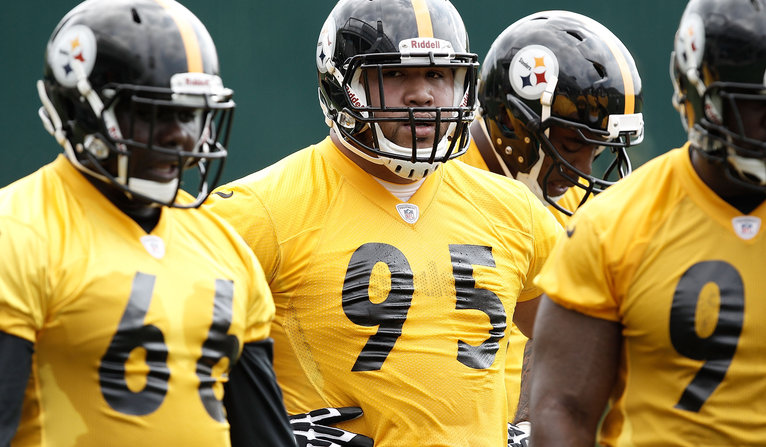Marketplace Tech

Fourth round draft pick Alameda Ta’amu, #95 of the Pittsburgh Steelers, works out during rookie minicamp at the Pittsburgh Steelers South Side training facility on May 4, 2012 in Pittsburgh, Pennsylvania.
by David Gura
Thursday, April 25, 2013 – 02:55
This is a big weekend for Jahleel Addae, a former defensive back for the Central Michigan University Chippewas. The NFL Draft starts tonight, and he is hoping to go pro.
Earlier this year, Addae went to what’s called an NFL Pro Day, where scouts, coaches, and general managers got a chance to watch him work out and meet with him.
“Sometimes I feel like they know more about me than I know about myself, you know?” Addae says.
That’s not too far-fetched. The way pro football teams pick players has become increasingly data-driven. They want to feel like they’re making the safest bet possible, particularly when multi-million dollar salaries are stake.
“The data is a very important aspect in evaluating players,” says Steve Baker, a San Francisco-based agent who runs Baker Sports Management. “Players have gotten much more sophisticated in the last 20 years of trying to improve that data.”
Coaches use to pay a lot of attention to three things, in particular: height, weight and speed — that was based on how fast players ran the 40-yard dash.
“Now, they’ll look more at their acceleration in the first10-yards,” Baker says. “Or specifics on how that player would perform on the field.”
Coaches are trying to quantify as much as they can. How many times a player can bench press 225 lbs., how high he can jump, and how far he can jump. They want to know as much as they can about a player’s agility — his “lateral quickness.” There are strength tests and IQ tests.
A franchise builds up a big dossier of data on every player, and to make sense of that, many of them turn to scouting consultants, like Eric Galko.
“I know two or three teams that have kind of a decision-making software, where they can kind of plug in their grades and evaluations on players,” he says.
Data can help, but according to Kenneth Shropshire, a sports lawyer who teaches at The Wharton School at the University of Pennsylvania, there’s a risk of information overload.
“The clubs are spending a lot of time figuring out which data is the most valuable,” he says.
Even if you know everything there is to know about a player like Jahleel Addae — tackles, sacks, kick returns, and interceptions — what you don’t know, what you can’t know, is how he will fit in with the rest of the team.
How is all this calculated?
1. Look at a player’s college career
Teams start with the stats from the player’s college career. If he is a quarterback, teams will look at pass completions, pass attempts, passing yards, touchdown passes, interceptions, and rushing yards. Then, there is his passer rating. If he is a running back, teams will look at rushing yards, rushing yards per game, receptions, receiving yards, and rushing touchdowns.
Steve Baker, a San Francisco-based agent, says “statistics have gotten much, much more sophisticated.” He says a team may be interested in how a quarterback performs under certain circumstances — say, in the fourth quarter, when the team is down by a field goal.
2: Get the basic information on each player
Franchises collect basic information about players.
“They weigh them, they measure them, and they review their entire medical history,” David Berri, who teaches sports economics at Southern Utah University says. If a player has been injured in the past, team doctors will re-examine the injury and, if necessary, run more tests and take more X-rays.
3: Put them all in the Combine
Teams collect a lot of data at the NFL Scouting Combine, which takes place every year in Indianapolis, Ind., and at Pro Daysacross the country. College football players get the opportunity to work out in front of coaches, scouts, and general managers. There is information, from the NFL, on all the workouts here.
4: Answer specific questions in the Combine
How fast can a player run the 40-yard dash? As Steve Baker, the president of Baker Sports Management, points out, teams are parsing that sprint. “Now, they’ll look more at their acceleration in the first ten yards,” he says.
How many times can a player bench press 225 lbs.?
How high can a player jump?
How far can a player jump?
5: The written exams
In addition to the Combine, there are all sorts of drills. Teams administer the Wonderlic Cognitive Ability Test. They also test a player’s knowledge of the game itself.
They ask questions like:
If the first two statements are true, is the final statement true?
Sandra is responsible for ordering all office supplies.
Notebooks are office supplies.Sandra is responsible for ordering notebooks.
A) yes B) no C) uncertain
See a host of sample questions here.
6: Just who is this guy, again?
Teams also look at films, and they’ll talk to former coaches to get a sense of a player’s character. Howwill a player behave on the field or in the locker room? The San Francisco 49ers hire Harry Edwards, who used to be a professor of sociology at the University of California, Berkeley, to look at how a player could interact with the team.